|
ABEL SANTAMARÍA MUSEUM PARK
Among the remains of the old Saturnino Lora Civilian Hospital, a building that dates back to 1865, is located a beautiful and solemn spot in Santiago de Cuba, where a group of young people attacked the hospital on July 26th of 1953.
Another historical event took place on October 16th of that same year, where the trial against Fidel Castro, regarding the events of the Moncada Garrison, took place and where he pronounced his famous historical defence named History will Absolve Me (La Historia me Absolverá).
It was opened to the public as a Museum in 1973 and its rooms exhibit the hospital’s story, as well as personal objects of the attackers of the Moncada Garrison and the room where the trial took place. It was declared a National Monument on July 10th of 1998.
For more information:
www.cuba-heroes.com
,
www.cuba-history.com
,
www.cuba-museums.com
,
www.cuba-santiagodecuba.com
|
|
|
ANCIENT FENCE OF SAN BARTOLO (ANTIGUA VALLA DE SAN BARTOLO)
This is located in the town of Baire some 50 metres from the plaza. On February 24th of 1895 the “valleros” of the area concentrated themselves in this place from the early hours of the morning, and those who heard the speech of the Commander of the 1868 war Florencio Salcedo, who was judge of the fence that day, who said “...enough cockfighting, it time for men to fight and not animals, for Cuba’s independence”... went to the plaza, where Captain Saturnino Lora was waiting for them in order to restart the final struggle for Cuba’s independence.
It was declared a National Monument on December 25th of 1979.
For more information:
www.cuba-culturaltours.com
,
www.cuba-heroes.com
,
www.cuba-history.com
,
www.cuba-santiagodecuba.com
|
|
|
ARTS AND CRAFTS SCHOOL (ESCUELA DE ARTES Y OFICIOS)
This well known educational institution is located in the centre of Santiago de Cuba and was hailed a National Monument on January 20th of 2000.
The students and teachers were the stars of important revolutionary struggles through out history, one of the most outstanding students being Félix Pena Díaz.
The school was opened in 1928 with the aim of satisfying the demand of skilled labour while at the same time becoming a possibility of higher education for the lower classes, which were denied access to higher-level studies.
A fire destroyed the place in 1940 and the construction of the new building was finished and opened on January 17th of 1948.
For more information:
www.cuba-education.com
,
www.cuba-heroes.com
,
www.cuba-santiagodecuba.com
|
|
|
BAIRE PLAZA
This site, located in the town of the same name in Santiago de Cuba, was declared a National Monument and is where the troops led by Carlos Manuel de Céspedes, also known as Father of the Homeland (Padre de la Patria), and José Joaquín Palma, a poet from Manzanillo, were concentrated.
As fate had it, on February 24th of 1895, when the struggle for independence was taken up again, Captain Saturnino Lora exclaimed: The time has come for breaking the chains that bind us to the tyranny, and to prove this, lets hail Cuba, but you should know that with the blades of our machetes and the bullets of our rifles and cannons we are to defend the homeland…
He immediately took out his revolver and fired six bullets to demonstrate to Spain and the world that his soldiers were faithful defenders of Cuban nationality.
For more information:
www.cuba-culturaltours.com
,
www.cuba-heroes.com
,
www.cuba-history.com
,
www.cuba-santiagodecuba.com
|
|
|
BATEY OF THE AMÉRICA LIBRE SUGAR MILL
Located in the ancient sugar mill called Oriente, property of The Sugar State of Oriente (Covered by the American Howell Group) it became the most important scene of the worker’s struggle in Contramaestre.
Here is the house where the Rebel Command (Comandancia Rebelde) was established on December 19th of 1958, and it was also the scene for important events related to the last period of the insurrectional struggle against Batista’s dictatorship in Cuba.
In this place the Commander in Chief Fidel Castro designed the strategy for following and neutralising the enemy’s attempts to ruin the Revolution’s triumph. It was declared a National Monument on October 7th of 2000.
For more information:
www.cuba-history.com
,
www.cuba-sugar.com
,
www.cuba-santiagodecuba.com
,
www.gocubaplus.com
|
|
|
CASTLE OF SAN PEDRO DE LA ROCA
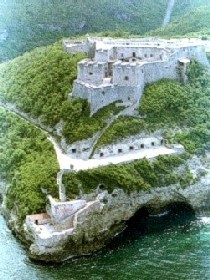 The castle, also known as the Morro Castle, was constructed between 1638 and 1643 by military engineer Juan Bautista Antonelli. The fort houses the museum of piracy and is a national monument.
The castle was declared World Heritage by Mr. Bernd von Droste, director of the World Heritage Center. “This is a remarkable example of Hispanic-American military architecture” said Von Droste in the proclamation ceremony. The Castle of San Pedro de la Roca has many historical, artistic, and architectonic values. This city is a must for the tourists.
The castle, also known as the Morro Castle, was constructed between 1638 and 1643 by military engineer Juan Bautista Antonelli. The fort houses the museum of piracy and is a national monument.
The castle was declared World Heritage by Mr. Bernd von Droste, director of the World Heritage Center. “This is a remarkable example of Hispanic-American military architecture” said Von Droste in the proclamation ceremony. The Castle of San Pedro de la Roca has many historical, artistic, and architectonic values. This city is a must for the tourists.
For more information:
www.cuba-santiagodecuba.com
|
|
|
CAT’S HILL (LOMA DEL GATO)
Located in the eastern municipality of Songo La Maya, the area won its place in Cuba’s history when on July 5th of 1896, the fatal combat where the legendary eastern lion (León de Oriente), José Maceo Grajales, brother of Lieutenant General Antonio Maceo was mortally wounded.
José, son of a legendary lineage of titans, gave his last breath to his homeland, after fighting endlessly and bravely against the Spanish colonialism during the XIX century.
This important site in the eastern mountains was the scene of his last battle, where his spirit lives on, that is why it was declared a National Monument to honour the Eastern Lion (León de Oriente).
For more information:
www.cuba-heroes.com
,
www.cuba-history.com
,
www.cuba-santiagodecuba.com
|
|
|
DOLORES CHURCH. SANTIAGO DE CUBA
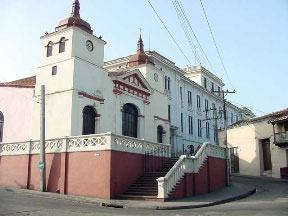 In its beginning it was the Church of Our Lady of Dolores (Iglesia de Nuestra Señora de los Dolores), built in the XVII century in a city charged with legends and history. Starting from January 1989, after the ecclesiastical authorities donated the building to Santiago de Cuba, the beautiful and well kept construction became a Concert Hall.
This place is not only appreciated due to its architectural attributes, but also for its excellent acoustic qualities, tested on symphonies, lyrical concerts and chamber music, as well as in annual international choir festivals, organised by the authorities in charge of fostering cultural development in the territory. The concert hall features a Rieger-Kloss organ, an instrument that comes from a prestigious Czechoslovakian company that has created more than 400 of its kind worldwide.
In its beginning it was the Church of Our Lady of Dolores (Iglesia de Nuestra Señora de los Dolores), built in the XVII century in a city charged with legends and history. Starting from January 1989, after the ecclesiastical authorities donated the building to Santiago de Cuba, the beautiful and well kept construction became a Concert Hall.
This place is not only appreciated due to its architectural attributes, but also for its excellent acoustic qualities, tested on symphonies, lyrical concerts and chamber music, as well as in annual international choir festivals, organised by the authorities in charge of fostering cultural development in the territory. The concert hall features a Rieger-Kloss organ, an instrument that comes from a prestigious Czechoslovakian company that has created more than 400 of its kind worldwide.
For more information:
www.cuba-santiagodecuba.com
|
|
|
EL JIGÜE
This place is located in the mountainous municipality of Guamá. It was declared a National Monument on December 25th of 1979 and was associated with the last stage of the insurrectional process towards the end of the 1850’s.
Here the Rebel Army (Ejército Rebelde) troops held a bloody battle with the army of Fulgencio Batista’s dictatorship. This battle raged from the 11th to the 21st of July of 1958 and was led by the Commander in Chief Fidel Castro.
In this fight, the brave rebel Captain Andrés Cuevas Heredia lost his life on July 19th. For the enemy, the fact that one of its best combat units was completely dismantled, constituted a physical and moral defeat.
For more information:
www.cuba-culturaltours.com
,
www.cuba-heroes.com
,
www.cuba-history.com
,
www.cuba-santiagodecuba.com
|
|
|
FRANK PAÍS GARCÍA MUSEUM HOUSE
It opened its doors as a museum on November 30th of 1964, and since then it exhibits photographs, documents and personal objects of the País García brothers and their family. It was declared a National Monument on October 10th of 1978.
The house was built during the second half of the XIX century. The brothers Frank and Josué País García, brave young men that played an important part in the struggle against Fulgencio Batista’s dictatorship, are honoured here.
Frank, a teacher, organised and directed the armed struggle that took place on November 30th of 1956 in Santiago de Cuba, in support of the landing of the Granma yacht; and later on he was named chief of action and sabotage of the 26 of July movement by Commander in Chief Fidel Castro.
Frank was evilly murdered in the street (Callejón del Muro) on July 30th of 1957, one month after his brother Josué’s death.
For more information:
www.cuba-history.com
,
www.cuba-museums.com
,
www.cuba-santiagodecuba.com
|
|
|
FRENCH COFFEE PLANTATIONS
Here in Santiago of Cuba, the French and Haitian cultural legacy can be seen, it is a part not only of its history but also of its memory and tradition. It is not a coincidence that the Archaeological Landscape (Paisaje Arqueológico) of coffee plantations is among the World Heritage sites as well as being declared a Cuban National Monument.
These coffee plantations that date back to the end of the XVII and beginning of the XIX century have also been declared as a Heritage of Humanity by UNESCO in the year 2000. There are over a hundred of these plantations, most of them located in the province of Santiago de Cuba, covering the area of the Great Stone (Gran Piedra), El Cobre, Dos Palmas and Contramaestre, although there are many others also in Guantánamo.
The most famous ruins are located in the farmstead of Santa Sofía, Kentucky and La Isabelica, the latter has been perfectly preserved and today houses an ethnographic museum.
For more information:
www.cuba-coffee.com
,
www.cuba-culturaltours.com
,
www.cuba-santiagodecuba.com
|
|
|
HEADQUARTERS OF THE II EASTERN FRONT
(COMANDANCIA DEL II FRENTE ORIENTAL)
On March 11th of 1958 this military site was built with the name of II Eastern Front Frank País García (II Frente Oriental Frank País García) and was headed by Commander Raúl Castro Ruz. It covered an area of 12 000 square kilometres that includes the municipalities of Mayarí, Sagua de Tánamo, Baracoa, Yateras, Guantánamo, Alto Songo and San Luis and for the next trimester of the struggle against Fulgencio Batista’s dictatorship, its control was extended to Banes and Antilla.
In this area on December 7th of 1958 the Rebel Air Force (Fuerza Aérea Rebelde) carried out its first successful combat mission.
After the Revolution’s triumph in Cuba, on October 10th of 1978 the National Monument Commission (Comisión Nacional de Monumentos), in order to honour the work carried out by this Front in the struggle for enduring independence, agreed to proclaim it a National Monument.
For more information:
www.cuba-culturaltours.com
,
www.cuba-heroes.com
,
www.cuba-history.com
,
www.cuba-santiagodecuba.com
|
|
|
HEADQUARTERS OF THE III EASTERN FRONT
(COMANDANCIA DEL III FRENTE ORIENTAL)
The historic military site headed by the then Commander Juan Almeida Bosque was officially constituted on March 15th of 1958 and covered an area of approximately 6 022 square kilometres.
This site was chosen due to the fact that the Rebel Army (Ejército Rebelde) was ready to extend the revolutionary war to other areas of the eastern region, as of the first months of 1958, which would force the enemy troops to keep up more than one theatre of operations. This site was declared a National Monument on October 10th of 1978.
For more information:
www.cuba-culturaltours.com
,
www.cuba-heroes.com
,
www.cuba-history.com
,
www.cuba-santiagodecuba.com
|
|
|
HISTORICAL QUARTERS, SANTIAGO DE CUBA
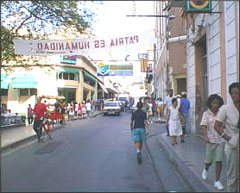 The city was founded on July 25th of 1515, so that it treasures a great and important variety of fights and struggles, from those waged against Spanish colonialism up to becoming an insurmountable bastion in the resistance against Fulgencio Batista’s dictatorship.
The historical quarters evolved rapidly covering an area of 2.5 square kilometres, where many examples of typical colonial and republican architecture can be seen along the narrow winding streets, as well as the stone steps, plazas, churches, parks and natural look outs.
The heart of the unique Heroic City of Cuba was declared a National Monument and President Fidel Castro has called it the Revolution’s birthplace.
The city was founded on July 25th of 1515, so that it treasures a great and important variety of fights and struggles, from those waged against Spanish colonialism up to becoming an insurmountable bastion in the resistance against Fulgencio Batista’s dictatorship.
The historical quarters evolved rapidly covering an area of 2.5 square kilometres, where many examples of typical colonial and republican architecture can be seen along the narrow winding streets, as well as the stone steps, plazas, churches, parks and natural look outs.
The heart of the unique Heroic City of Cuba was declared a National Monument and President Fidel Castro has called it the Revolution’s birthplace.
For more information:
www.cuba-history.com
,
www.cuba-santiagodecuba.com
|
|
|
HOUSE OF DIEGO VELAZQUEZ
 Located in Santiago de Cuba, this building is known as the House of Diego Velásquez, due to the fact that the founder of the city established his offices here (lower level) and also his residence (upper level). Its construction dates back to between 1516 and 1530, and it is considered the most ancient house in Cuba. It is the seat of the Museum of the Cuban Historical Environment (Museo de Ambiente Histórico Cubano) and there are those that identify it as a Museum of Colonial Art (Museo de Arte Colonial), because it exhibits different objects of the XVI century and of the second half of the XIX: ceramics, tapestries, weapons, shields and mirrors, among others.
The historical wealth is such that people have named the house the Museum of Furniture (Museo del Mueble), due to its extensive exhibits.
Located in Santiago de Cuba, this building is known as the House of Diego Velásquez, due to the fact that the founder of the city established his offices here (lower level) and also his residence (upper level). Its construction dates back to between 1516 and 1530, and it is considered the most ancient house in Cuba. It is the seat of the Museum of the Cuban Historical Environment (Museo de Ambiente Histórico Cubano) and there are those that identify it as a Museum of Colonial Art (Museo de Arte Colonial), because it exhibits different objects of the XVI century and of the second half of the XIX: ceramics, tapestries, weapons, shields and mirrors, among others.
The historical wealth is such that people have named the house the Museum of Furniture (Museo del Mueble), due to its extensive exhibits.
For more information:
www.cuba-museums.com
,
www.cuba-santiagodecuba.com
|
|
|
HOUSE OF TROVA (SANTIAGO DE CUBA)
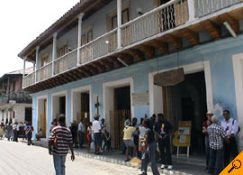 It is a picturesque institution located in the historical centre of the Heroic City (Ciudad Héroe) where authors and singers gather, bent on keeping alive the most beautiful traditions of Cuban popular music. With this purpose in mind, every year the Pepe Sánchez Trova Festival is held, where troubadours, romantics and bohemians leave their legacy at the birthplace of trova and son. You can ask yourself: What is the trova?
It is simply a synonym of guitars and poetry, of bohemians and rum, of love and street music; at least, that is how it was in its beginning in the XIX century.
Santiago de Cuba is an infinite seeding ground of a tradition that is very much alive. Visiting the house and being in direct contact with part of the rich musical history of Cuba makes it a unique and unforgettable experience that will burn itself into your memory.
It is a picturesque institution located in the historical centre of the Heroic City (Ciudad Héroe) where authors and singers gather, bent on keeping alive the most beautiful traditions of Cuban popular music. With this purpose in mind, every year the Pepe Sánchez Trova Festival is held, where troubadours, romantics and bohemians leave their legacy at the birthplace of trova and son. You can ask yourself: What is the trova?
It is simply a synonym of guitars and poetry, of bohemians and rum, of love and street music; at least, that is how it was in its beginning in the XIX century.
Santiago de Cuba is an infinite seeding ground of a tradition that is very much alive. Visiting the house and being in direct contact with part of the rich musical history of Cuba makes it a unique and unforgettable experience that will burn itself into your memory.
For more information:
www.cuba-museums.com
,
www.cuba-santiagodecuba.com
|
|
|
LA GRAN PIEDRA (THE GREAT STONE)
This peculiar monolith has an extension of 8,295.33 acres and it is located in the Sierra Maestra National Park 18.64 mi from Santiago de Cuba. The rock is 738.19 ft above sea level; specialists estimate it weighs 70, 000 tons. The stone 167.32 ft long, 98.43 ft wide, and 85.30 ft high was included in the Guinnes Records Book.
Temperature drops of 4.00 degrees Celsius and a dense fog has been reported here due to its microclimate.
The vegetation consists mainly of ferns and orchids. The Cartacuba and the Tocororo are common birds in the region.
During the Cuban cycling tour the cyclists find this mountain stage as the most challenging.
For more information:
www.cuba-santiagodecuba.com
|
|
|
LA RINCONADA
It was the main campsite of Mayor General Calixto García, Head of the Eastern Department, due to its security and natural characteristics.
Over half a century later, during the struggle of the Rebel Army (Ejército Rebelde), the forces of Column #1 José Martí led by Commander in Chief Fidel Castro Ruz installed their main camp here.
From this strategic place, Fidel Castro directed his military operations that began in December of 1958 at the towns of Jiguaní, Baire, Maffo and Palma Soriano, strategic sites in the struggle for the final victory.
The National Monument Commission (Comisión Nacional de Monumentos) declared it a National Monument on December 25th of 1979.
For more information:
www.cuba-heroes.com
,
www.cuba-history.com
,
www.cuba-santiagodecuba.com
,
www.gocubaplus.com
|
|
|
LOMA DEL INTENDENTE AND SURROUNDING AREA
Santiago de Cuba, Heroic City of the Republic of Cuba, became a living historical monument related with the events of November 30th of 1956, when a group of young men led by Frank País, backing up the landing of the men on the Granma yacht, with Fidel Castro at the head of 81 men, raised up the whole city. Here the Museum of Clandestine Struggle (Museo de la Lucha Clandestina) has been located since 1976, in the same building where the dictator Fulgencio Batista had his police department.
In this area of the city, every stone, house and place were silent witnesses of the events that took place in order to achieve definite independence. It was declared a National Monument on December 25th of 1979.
For more information:
www.cuba-culturaltours.com
,
www.cuba-heroes.com
,
www.cuba-history.com
,
www.cuba-santiagodecuba.com
|
|
|
MANGOS DE BARAGUÁ
This place is in the Mella municipality, in the province of Santiago de Cuba and was declared a National Monument on October 10th of 1978 due to its significance in the struggles for independence.
On March 15th of 1878 the famous Baragua Protest (Protesta de Baraguá) took place. It was one of the most dignified and glorious events in the struggles of the Cuban Mambi Army against the Spanish Colonialist troops in the XIX century.
On this memorable occasion, Mayor General Antonio Maceo Grajales in his talks with the Spanish General Martínez Campos was able to bring up the ideas of the glorious Cry of Yara (Grito de Yara), protesting against the peace treaty lacking in independence signed previously at the Zanjon.
For more information:
www.cuba-culturaltours.com
,
www.cuba-heroes.com
,
www.cuba-history.com
,
www.cuba-santiagodecuba.com
|
|
|
MARTE SQUARE. SANTIAGO DE CUBA
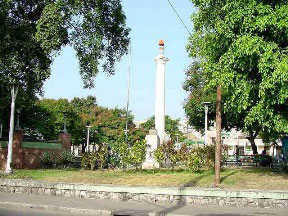 Also identified as Liberty Plaza (Plaza de la Libertad) it is one of the favourite spots of the people of the Heroic City (Ciudad Héroe), and of its visitors. It is among one of the most central and elevated points in the midst of the city’s vital arteries such as Aguilera, José A. Saco streets and it is the starting point of the popular Victoriano Garzón avenue.
The well known Liberty Column (Columna de la Libertad) is one of the Plaza’s attractions, where the Liberating Army of Cuba is honoured (Ejército Libertador de Cuba), for fighting for independence from Spain during the last third of the XIX century.
It was also raised in memory of other historical figures from Perucho Figueredo, author of Cuba’s National Anthem, to the Apostle José Martí. It is also the seat for one of the most renowned sports encounters in the country, mostly dedicated to baseball, the nation’s passion.
Also identified as Liberty Plaza (Plaza de la Libertad) it is one of the favourite spots of the people of the Heroic City (Ciudad Héroe), and of its visitors. It is among one of the most central and elevated points in the midst of the city’s vital arteries such as Aguilera, José A. Saco streets and it is the starting point of the popular Victoriano Garzón avenue.
The well known Liberty Column (Columna de la Libertad) is one of the Plaza’s attractions, where the Liberating Army of Cuba is honoured (Ejército Libertador de Cuba), for fighting for independence from Spain during the last third of the XIX century.
It was also raised in memory of other historical figures from Perucho Figueredo, author of Cuba’s National Anthem, to the Apostle José Martí. It is also the seat for one of the most renowned sports encounters in the country, mostly dedicated to baseball, the nation’s passion.
For more information:
www.cuba-nationalparks.com
,
www.cuba-santiagodecuba.com
|
|
|
MONCADA GARRISON (CUARTEL MONCADA)
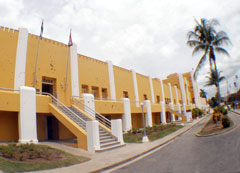 Its history started in 1859 when the first stone was placed on what was initially known as the Garrison of the New Prison (cuartel del Nuevo Presidio), because it was destined to serve as a departmental prison for the province of Santiago de Cuba. By decision of the colonial government of Spain, it was also called Garrison of Queen Mercedes and since 1902 it became the Moncada Garrison. In an attempt to take the barracks by assault, an action carried out by Fidel Castro at the head of a group of young revolutionaries, on July 26th of 1953, an armed assault charged the fortress, the second important in the country.
After the Revolution’s triumph in 1959, this military construction was turned into the School Centre 26 de Julio (Centro Escolar 26 de Julio), starting from January 28th of 1960 in honour of José Martí in the anniversary of his birth. Since then a museum has been installed here, where the truth is shown about what happened that day of the intrepid attack in the middle of the XX century.
Its history started in 1859 when the first stone was placed on what was initially known as the Garrison of the New Prison (cuartel del Nuevo Presidio), because it was destined to serve as a departmental prison for the province of Santiago de Cuba. By decision of the colonial government of Spain, it was also called Garrison of Queen Mercedes and since 1902 it became the Moncada Garrison. In an attempt to take the barracks by assault, an action carried out by Fidel Castro at the head of a group of young revolutionaries, on July 26th of 1953, an armed assault charged the fortress, the second important in the country.
After the Revolution’s triumph in 1959, this military construction was turned into the School Centre 26 de Julio (Centro Escolar 26 de Julio), starting from January 28th of 1960 in honour of José Martí in the anniversary of his birth. Since then a museum has been installed here, where the truth is shown about what happened that day of the intrepid attack in the middle of the XX century.
For more information:
www.cuba-history.com
,
www.cuba-santiagodecuba.com
|
|
|
Municipal Government, Santiago de Cuba
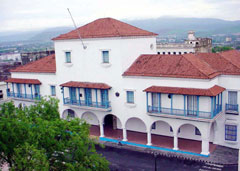 It is located in one of the corners of the legendary Céspedes Park and the building was conceived as a Municipal Palace, a function that it maintains today. Located within the Plaza Mayor, a central area where the buildings representing the colonial government were concentrated.
It is built along the lines of the colonial architecture of the time period and was opened on October 18th of 1954. The decorated main front as well as the rest of the building attract the visitor and offer a pleasant stay. From its central balcony Fidel Castro addressed the public on January 1st of 1959, the first day of the triumph of the newborn Revolution.
Another January 1st, but in the year of 1984, the city was awarded the Honorific Title of “Heroic City of the Republic of Cuba” (Ciudad Héroe de la República de Cuba) and the “Order Antonio Maceo". It is needless to say that the building has been hailed a National Monument.
It is located in one of the corners of the legendary Céspedes Park and the building was conceived as a Municipal Palace, a function that it maintains today. Located within the Plaza Mayor, a central area where the buildings representing the colonial government were concentrated.
It is built along the lines of the colonial architecture of the time period and was opened on October 18th of 1954. The decorated main front as well as the rest of the building attract the visitor and offer a pleasant stay. From its central balcony Fidel Castro addressed the public on January 1st of 1959, the first day of the triumph of the newborn Revolution.
Another January 1st, but in the year of 1984, the city was awarded the Honorific Title of “Heroic City of the Republic of Cuba” (Ciudad Héroe de la República de Cuba) and the “Order Antonio Maceo". It is needless to say that the building has been hailed a National Monument.
For more information:
www.cuba-history.com
,
www.cuba-santiagodecuba.com
|
|
|
MUNICIPAL HISTORICAL ARCHIVES (ARCHIVO HISTÓRICO MUNICIPAL) (Vivac)
Exactly in 1515 the Church of Santa Catalina (Iglesia Santa Catalina) was built here, and in 1522 it became the headquarters of the first Cathedral of Cuba, which was destroyed in 1828 by an earthquake, leaving a deserted landscape. Later on, a public jail was built and opened on November 17th of 1845.
In its cells many patriots, personalities and revolutionaries suffered imprisonment here, among them Emilio Bacardí, Perucho Figueredo and the English painter Walter Wordman, as well as a group of attackers of the Moncada Garrison (Cuartel Moncada) such as Fidel and Raúl Castro, Juan Almeida Bosque and Haydeé Santamaría.
Today the building houses the Office of Historical Archives of the City’s Preserver (Archivo Histórico de la Oficina del Conservador de la Ciudad) where many valuable documents have been deposited since 1664. It was declared a National Monument on July 20th of 1999.
For more information:
www.cuba-history.com
,
www.cuba-santiagodecuba.com
,
www.gocubaplus.com
|
|
|
National Sanctuary of the Virgin in El Cobre
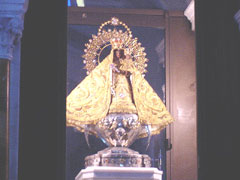 The Temple of El Cobre (Ermita de El Cobre), only 19 kilometres from Santiago of Cuba, has become a traveller’s destination, because it is the main site of the Virgin of the Caridad del Cobre, patron saint of the Cuban Catholics.
Her altar was built in marble and her silhouette is generally situated as facing the chapel of the Sanctuary, which is entered through the back, located above the “Chapel of Miracles” (Capilla de los Milagros), where objects of many loyal parishioners lie. One very special donor was the American novelist Ernest Hemingway, who in 1956 gave the Cubans the medal for the Nobel Prize of Literature of 1954.
On December 30th of 1977, the Pope Paulo VI sent the African Cardinal Bernardín Gantin as his emissary, in order to proclaim the Temple a “Minor Basilisk“ (Basílica Menor). The Holy Father Juan Pablo II crowned the Virgin again during his visit to Cuba in 1998.
The Temple of El Cobre (Ermita de El Cobre), only 19 kilometres from Santiago of Cuba, has become a traveller’s destination, because it is the main site of the Virgin of the Caridad del Cobre, patron saint of the Cuban Catholics.
Her altar was built in marble and her silhouette is generally situated as facing the chapel of the Sanctuary, which is entered through the back, located above the “Chapel of Miracles” (Capilla de los Milagros), where objects of many loyal parishioners lie. One very special donor was the American novelist Ernest Hemingway, who in 1956 gave the Cubans the medal for the Nobel Prize of Literature of 1954.
On December 30th of 1977, the Pope Paulo VI sent the African Cardinal Bernardín Gantin as his emissary, in order to proclaim the Temple a “Minor Basilisk“ (Basílica Menor). The Holy Father Juan Pablo II crowned the Virgin again during his visit to Cuba in 1998.
For more information:
www.cuba-religion.com
,
www.cuba-santiagodecuba.com
|
|
|
NORMAL SCHOOL FOR TEACHERS
(ESCUELA NORMAL PARA MAESTROS)
It has been declared a National Monument since 1997. It was built at the beginning of the XX century with donations from the American state of Massachusetts and funds from the Cuban state.
The first Model School (Escuela Modelo) for grade students was located here, and later in 1916 the Eastern Normal School (Escuela Normal de Oriente). It teachers were made up of famous personalities of Cuban culture such as Max Henríquez Ureña, Francisco Henríquez Carvajal and Rodolfo Hernández Giro.
According to documents of the times, there is proof that in 1930 the Spanish poet Federico García Lorca visited this school. In this centre, many revolutionaries from Santiago de Cuba carried out their studies here, and later on gave up their lives in different patriotic events.
For more information:
www.cuba-culturaltours.com
,
www.cuba-education.com
,
www.cuba-history.com
,
www.cuba-santiagodecuba.com
|
|
|
Padre Pico Street
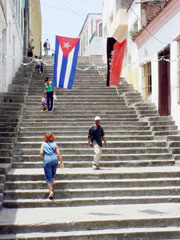 Padre Pico Street is one of the more picturesque places of the Heroic City of Santiago of Cuba (Ciudad Héroe de Santiago de Cuba) located in the city’s centre. It was first named Cuesta de Amuedo, later on as Hospital Street and then Loma de Corpacho.
This unique street in Santiago adopted its current name in 1942 in honour of the priest Bernardo del Pico (1726-1813) a man who dedicated his life to practicing good, helping the poor, attending to the sick, protecting the homeless and who left his wealth to the construction of a beneficial society.
Padre Pico Street is one of the more picturesque places of the Heroic City of Santiago of Cuba (Ciudad Héroe de Santiago de Cuba) located in the city’s centre. It was first named Cuesta de Amuedo, later on as Hospital Street and then Loma de Corpacho.
This unique street in Santiago adopted its current name in 1942 in honour of the priest Bernardo del Pico (1726-1813) a man who dedicated his life to practicing good, helping the poor, attending to the sick, protecting the homeless and who left his wealth to the construction of a beneficial society.
For more information:
www.cuba-history.com
,
www.cuba-santiagodecuba.com
|
|
|
PALACE OF JUSTICE (PALACIO DE JUSTICIA)
This building was declared a National Monument on July 10 of 1998, according to Resolution No.151 of the National Monument Commission (Comisión Nacional de Monumentos).
The building was built in the decade of the forties in the XX century and it celebrated two public audiences related to causes number 37 of 1953 and number 67 of1956.
The first was the trial against the survivors of the revolutionary armed attack that took place on July 26th, processing 30 attackers of the Garrisons of Santiago de Cuba and Bayamo. In the second trial, they were accused of involvement in the armed upraising of the people on November 30th of 1956 in support of the landing of the Granma yacht.
For more information:
www.cuba-culturaltours.com
,
www.cuba-heroes.com
,
www.cuba-history.com
,
www.cuba-santiagodecuba.com
|
|
|
PINOS DE BAIRE
The Spanish Army tried to take back this area after the fall of the city of Bayamo into insurrectional hands on October 20th of 1868.
The Cuban Mambi troops led by the Dominican Sargent Máximo Gómez Báez were in charge of detaining the advance of these troops in the area of Baire. The action was carried out by the local troops mainly using the machete as weapon. From this point on the use of this short sword as a weapon became common.
Due to the historical importance of this fact, the National Monument Commission (Comisión Nacional de Monumentos) decided to declare this site a National Monument on December 25th of 1979.
For more information:
www.cuba-heroes.com
,
www.cuba-history.com
,
www.cuba-santiagodecuba.com
,
www.gocubaplus.com
|
|
|
SAN LORENZO
Located in the municipality of III Frente Oriental Mario Muñoz Monroy, in Santiago de Cuba it occupies a place in history for being the site where the Father of the Homeland (Padre de la Patria), Carlos Manuel de Céspedes lived out his last days.
Céspedes was the first president of the Republic of Cuba in Arms (República de Cuba en armas) and later on was deposed due to misunderstandings, retired to this place and dedicated himself to being a teacher.
As destiny had it, on February 27 of 1874 he was warned that nearby there was a Spanish group of soldiers. He immediately went out with his revolver in his hand and was hunted by the Spanish. Almost at the top of a hill he was mortally shot and fell down a ravine.
Due to the events, this site was declared a National Monument on December 25th of 1979.
For more information:
www.cuba-heroes.com
,
www.cuba-history.com
,
www.cuba-santiagodecuba.com
,
www.gocubaplus.com
|
|
|
SANTA IFIGENIA CEMETERY
The cemetery was inaugurated on April 22nd 1868. it has an extension of 264,058.40 sq ft and it’s regarded as a museum.
Several illustrious Cubans are buried here: National Hero José Martí; Founding Father Carlos Manuel de Céspedes; Mariana Grajales, mother of the Maceo brothers; Frank País, murdered during the Batista dictatorship.
The cemetery is plethoric of funeral art samples in a magnificent state of preservation.
The city, a living piece of Cuban history, was declared as National Monument on October 10th, 1988.
For more information:
www.cuba-santiagodecuba.com
|
|
|
SANTIAGO DE CUBA
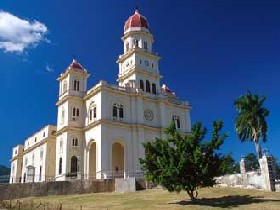 Santiago is the capital city of the province of the same name. Santiago de Cuba has a unique history, very distinctive people, and musical roots enriched by the mixture of races and cultures that make this city the most Caribbean city of Cuba.
The city is the only Cuban city to hold the title of “Hero City of the Republic of Cuba”.
The streets of city are full of historic events by its brave people from the first wars of independence in the 19th century to the attack on the Moncada Barracks in 1953.
Seventeen sites of the city are considered national monuments; this brave city has history everywhere.
The city was founded in 1515 marking the beginning of the Spanish colonialism in the Caribbean. The historical center stretches for 1.55 sq mi. The city sits on top of marine terraces and it’s sheltered by the Sierra Maestra mountain range. The historical center’s limits mark the extension the city had until late 19th century. It shows many elements of colonial and republican architecture.
The city’s superb natural resources favor the practice of ecotourism, especially trailing and adventure tourism; and it has an adequate infrastructure for congress tourism as well as nautical sports, cruises, and health tourism.
Santiago is the capital city of the province of the same name. Santiago de Cuba has a unique history, very distinctive people, and musical roots enriched by the mixture of races and cultures that make this city the most Caribbean city of Cuba.
The city is the only Cuban city to hold the title of “Hero City of the Republic of Cuba”.
The streets of city are full of historic events by its brave people from the first wars of independence in the 19th century to the attack on the Moncada Barracks in 1953.
Seventeen sites of the city are considered national monuments; this brave city has history everywhere.
The city was founded in 1515 marking the beginning of the Spanish colonialism in the Caribbean. The historical center stretches for 1.55 sq mi. The city sits on top of marine terraces and it’s sheltered by the Sierra Maestra mountain range. The historical center’s limits mark the extension the city had until late 19th century. It shows many elements of colonial and republican architecture.
The city’s superb natural resources favor the practice of ecotourism, especially trailing and adventure tourism; and it has an adequate infrastructure for congress tourism as well as nautical sports, cruises, and health tourism.
For more information:
www.cuba-santiagodecuba.com
|
|
|
UVERO
A memorable battle of the Rebel Army (Ejército Rebelde) against the troops of Batista’s dictatorship took place in this area of the present day municipality of Guamá on May 28th of 1957. Commander in Chief Fidel Castro led the combat.
It is known as the greatest battle fought by the Rebel Army (Ejército Rebelde) and was a starting point for developing the insurrectional struggle against the enemy forces, demonstrating the existence of the struggle that could no longer be hidden by the authorities.
The high combat capacity of the Rebel troops was proved, as well as the importance of the farmers in the area, in collaborating and fighting side by side along the troops. According to Che this battle marked the coming of age of the Rebel Army (Ejército Rebelde). It was declared a National Monument on December 25th of 1979.
For more information:
www.cuba-culturaltours.com
,
www.cuba-heroes.com
,
www.cuba-history.com
,
www.cuba-santiagodecuba.com
|
|
 The castle, also known as the Morro Castle, was constructed between 1638 and 1643 by military engineer Juan Bautista Antonelli. The fort houses the museum of piracy and is a national monument.
The castle was declared World Heritage by Mr. Bernd von Droste, director of the World Heritage Center. “This is a remarkable example of Hispanic-American military architecture” said Von Droste in the proclamation ceremony. The Castle of San Pedro de la Roca has many historical, artistic, and architectonic values. This city is a must for the tourists.
The castle, also known as the Morro Castle, was constructed between 1638 and 1643 by military engineer Juan Bautista Antonelli. The fort houses the museum of piracy and is a national monument.
The castle was declared World Heritage by Mr. Bernd von Droste, director of the World Heritage Center. “This is a remarkable example of Hispanic-American military architecture” said Von Droste in the proclamation ceremony. The Castle of San Pedro de la Roca has many historical, artistic, and architectonic values. This city is a must for the tourists.
 In its beginning it was the Church of Our Lady of Dolores (Iglesia de Nuestra Señora de los Dolores), built in the XVII century in a city charged with legends and history. Starting from January 1989, after the ecclesiastical authorities donated the building to Santiago de Cuba, the beautiful and well kept construction became a Concert Hall.
This place is not only appreciated due to its architectural attributes, but also for its excellent acoustic qualities, tested on symphonies, lyrical concerts and chamber music, as well as in annual international choir festivals, organised by the authorities in charge of fostering cultural development in the territory. The concert hall features a Rieger-Kloss organ, an instrument that comes from a prestigious Czechoslovakian company that has created more than 400 of its kind worldwide.
In its beginning it was the Church of Our Lady of Dolores (Iglesia de Nuestra Señora de los Dolores), built in the XVII century in a city charged with legends and history. Starting from January 1989, after the ecclesiastical authorities donated the building to Santiago de Cuba, the beautiful and well kept construction became a Concert Hall.
This place is not only appreciated due to its architectural attributes, but also for its excellent acoustic qualities, tested on symphonies, lyrical concerts and chamber music, as well as in annual international choir festivals, organised by the authorities in charge of fostering cultural development in the territory. The concert hall features a Rieger-Kloss organ, an instrument that comes from a prestigious Czechoslovakian company that has created more than 400 of its kind worldwide.
 The city was founded on July 25th of 1515, so that it treasures a great and important variety of fights and struggles, from those waged against Spanish colonialism up to becoming an insurmountable bastion in the resistance against Fulgencio Batista’s dictatorship.
The historical quarters evolved rapidly covering an area of 2.5 square kilometres, where many examples of typical colonial and republican architecture can be seen along the narrow winding streets, as well as the stone steps, plazas, churches, parks and natural look outs.
The heart of the unique Heroic City of Cuba was declared a National Monument and President Fidel Castro has called it the Revolution’s birthplace.
The city was founded on July 25th of 1515, so that it treasures a great and important variety of fights and struggles, from those waged against Spanish colonialism up to becoming an insurmountable bastion in the resistance against Fulgencio Batista’s dictatorship.
The historical quarters evolved rapidly covering an area of 2.5 square kilometres, where many examples of typical colonial and republican architecture can be seen along the narrow winding streets, as well as the stone steps, plazas, churches, parks and natural look outs.
The heart of the unique Heroic City of Cuba was declared a National Monument and President Fidel Castro has called it the Revolution’s birthplace.
 Located in Santiago de Cuba, this building is known as the House of Diego Velásquez, due to the fact that the founder of the city established his offices here (lower level) and also his residence (upper level). Its construction dates back to between 1516 and 1530, and it is considered the most ancient house in Cuba. It is the seat of the Museum of the Cuban Historical Environment (Museo de Ambiente Histórico Cubano) and there are those that identify it as a Museum of Colonial Art (Museo de Arte Colonial), because it exhibits different objects of the XVI century and of the second half of the XIX: ceramics, tapestries, weapons, shields and mirrors, among others.
The historical wealth is such that people have named the house the Museum of Furniture (Museo del Mueble), due to its extensive exhibits.
Located in Santiago de Cuba, this building is known as the House of Diego Velásquez, due to the fact that the founder of the city established his offices here (lower level) and also his residence (upper level). Its construction dates back to between 1516 and 1530, and it is considered the most ancient house in Cuba. It is the seat of the Museum of the Cuban Historical Environment (Museo de Ambiente Histórico Cubano) and there are those that identify it as a Museum of Colonial Art (Museo de Arte Colonial), because it exhibits different objects of the XVI century and of the second half of the XIX: ceramics, tapestries, weapons, shields and mirrors, among others.
The historical wealth is such that people have named the house the Museum of Furniture (Museo del Mueble), due to its extensive exhibits.
 It is a picturesque institution located in the historical centre of the Heroic City (Ciudad Héroe) where authors and singers gather, bent on keeping alive the most beautiful traditions of Cuban popular music. With this purpose in mind, every year the Pepe Sánchez Trova Festival is held, where troubadours, romantics and bohemians leave their legacy at the birthplace of trova and son. You can ask yourself: What is the trova?
It is simply a synonym of guitars and poetry, of bohemians and rum, of love and street music; at least, that is how it was in its beginning in the XIX century.
Santiago de Cuba is an infinite seeding ground of a tradition that is very much alive. Visiting the house and being in direct contact with part of the rich musical history of Cuba makes it a unique and unforgettable experience that will burn itself into your memory.
It is a picturesque institution located in the historical centre of the Heroic City (Ciudad Héroe) where authors and singers gather, bent on keeping alive the most beautiful traditions of Cuban popular music. With this purpose in mind, every year the Pepe Sánchez Trova Festival is held, where troubadours, romantics and bohemians leave their legacy at the birthplace of trova and son. You can ask yourself: What is the trova?
It is simply a synonym of guitars and poetry, of bohemians and rum, of love and street music; at least, that is how it was in its beginning in the XIX century.
Santiago de Cuba is an infinite seeding ground of a tradition that is very much alive. Visiting the house and being in direct contact with part of the rich musical history of Cuba makes it a unique and unforgettable experience that will burn itself into your memory.
 Also identified as Liberty Plaza (Plaza de la Libertad) it is one of the favourite spots of the people of the Heroic City (Ciudad Héroe), and of its visitors. It is among one of the most central and elevated points in the midst of the city’s vital arteries such as Aguilera, José A. Saco streets and it is the starting point of the popular Victoriano Garzón avenue.
The well known Liberty Column (Columna de la Libertad) is one of the Plaza’s attractions, where the Liberating Army of Cuba is honoured (Ejército Libertador de Cuba), for fighting for independence from Spain during the last third of the XIX century.
It was also raised in memory of other historical figures from Perucho Figueredo, author of Cuba’s National Anthem, to the Apostle José Martí. It is also the seat for one of the most renowned sports encounters in the country, mostly dedicated to baseball, the nation’s passion.
Also identified as Liberty Plaza (Plaza de la Libertad) it is one of the favourite spots of the people of the Heroic City (Ciudad Héroe), and of its visitors. It is among one of the most central and elevated points in the midst of the city’s vital arteries such as Aguilera, José A. Saco streets and it is the starting point of the popular Victoriano Garzón avenue.
The well known Liberty Column (Columna de la Libertad) is one of the Plaza’s attractions, where the Liberating Army of Cuba is honoured (Ejército Libertador de Cuba), for fighting for independence from Spain during the last third of the XIX century.
It was also raised in memory of other historical figures from Perucho Figueredo, author of Cuba’s National Anthem, to the Apostle José Martí. It is also the seat for one of the most renowned sports encounters in the country, mostly dedicated to baseball, the nation’s passion.
 Its history started in 1859 when the first stone was placed on what was initially known as the Garrison of the New Prison (cuartel del Nuevo Presidio), because it was destined to serve as a departmental prison for the province of Santiago de Cuba. By decision of the colonial government of Spain, it was also called Garrison of Queen Mercedes and since 1902 it became the Moncada Garrison. In an attempt to take the barracks by assault, an action carried out by Fidel Castro at the head of a group of young revolutionaries, on July 26th of 1953, an armed assault charged the fortress, the second important in the country.
After the Revolution’s triumph in 1959, this military construction was turned into the School Centre 26 de Julio (Centro Escolar 26 de Julio), starting from January 28th of 1960 in honour of José Martí in the anniversary of his birth. Since then a museum has been installed here, where the truth is shown about what happened that day of the intrepid attack in the middle of the XX century.
Its history started in 1859 when the first stone was placed on what was initially known as the Garrison of the New Prison (cuartel del Nuevo Presidio), because it was destined to serve as a departmental prison for the province of Santiago de Cuba. By decision of the colonial government of Spain, it was also called Garrison of Queen Mercedes and since 1902 it became the Moncada Garrison. In an attempt to take the barracks by assault, an action carried out by Fidel Castro at the head of a group of young revolutionaries, on July 26th of 1953, an armed assault charged the fortress, the second important in the country.
After the Revolution’s triumph in 1959, this military construction was turned into the School Centre 26 de Julio (Centro Escolar 26 de Julio), starting from January 28th of 1960 in honour of José Martí in the anniversary of his birth. Since then a museum has been installed here, where the truth is shown about what happened that day of the intrepid attack in the middle of the XX century.
 It is located in one of the corners of the legendary Céspedes Park and the building was conceived as a Municipal Palace, a function that it maintains today. Located within the Plaza Mayor, a central area where the buildings representing the colonial government were concentrated.
It is built along the lines of the colonial architecture of the time period and was opened on October 18th of 1954. The decorated main front as well as the rest of the building attract the visitor and offer a pleasant stay. From its central balcony Fidel Castro addressed the public on January 1st of 1959, the first day of the triumph of the newborn Revolution.
Another January 1st, but in the year of 1984, the city was awarded the Honorific Title of “Heroic City of the Republic of Cuba” (Ciudad Héroe de la República de Cuba) and the “Order Antonio Maceo". It is needless to say that the building has been hailed a National Monument.
It is located in one of the corners of the legendary Céspedes Park and the building was conceived as a Municipal Palace, a function that it maintains today. Located within the Plaza Mayor, a central area where the buildings representing the colonial government were concentrated.
It is built along the lines of the colonial architecture of the time period and was opened on October 18th of 1954. The decorated main front as well as the rest of the building attract the visitor and offer a pleasant stay. From its central balcony Fidel Castro addressed the public on January 1st of 1959, the first day of the triumph of the newborn Revolution.
Another January 1st, but in the year of 1984, the city was awarded the Honorific Title of “Heroic City of the Republic of Cuba” (Ciudad Héroe de la República de Cuba) and the “Order Antonio Maceo". It is needless to say that the building has been hailed a National Monument.
 The Temple of El Cobre (Ermita de El Cobre), only 19 kilometres from Santiago of Cuba, has become a traveller’s destination, because it is the main site of the Virgin of the Caridad del Cobre, patron saint of the Cuban Catholics.
Her altar was built in marble and her silhouette is generally situated as facing the chapel of the Sanctuary, which is entered through the back, located above the “Chapel of Miracles” (Capilla de los Milagros), where objects of many loyal parishioners lie. One very special donor was the American novelist Ernest Hemingway, who in 1956 gave the Cubans the medal for the Nobel Prize of Literature of 1954.
On December 30th of 1977, the Pope Paulo VI sent the African Cardinal Bernardín Gantin as his emissary, in order to proclaim the Temple a “Minor Basilisk“ (Basílica Menor). The Holy Father Juan Pablo II crowned the Virgin again during his visit to Cuba in 1998.
The Temple of El Cobre (Ermita de El Cobre), only 19 kilometres from Santiago of Cuba, has become a traveller’s destination, because it is the main site of the Virgin of the Caridad del Cobre, patron saint of the Cuban Catholics.
Her altar was built in marble and her silhouette is generally situated as facing the chapel of the Sanctuary, which is entered through the back, located above the “Chapel of Miracles” (Capilla de los Milagros), where objects of many loyal parishioners lie. One very special donor was the American novelist Ernest Hemingway, who in 1956 gave the Cubans the medal for the Nobel Prize of Literature of 1954.
On December 30th of 1977, the Pope Paulo VI sent the African Cardinal Bernardín Gantin as his emissary, in order to proclaim the Temple a “Minor Basilisk“ (Basílica Menor). The Holy Father Juan Pablo II crowned the Virgin again during his visit to Cuba in 1998.
 Padre Pico Street is one of the more picturesque places of the Heroic City of Santiago of Cuba (Ciudad Héroe de Santiago de Cuba) located in the city’s centre. It was first named Cuesta de Amuedo, later on as Hospital Street and then Loma de Corpacho.
This unique street in Santiago adopted its current name in 1942 in honour of the priest Bernardo del Pico (1726-1813) a man who dedicated his life to practicing good, helping the poor, attending to the sick, protecting the homeless and who left his wealth to the construction of a beneficial society.
Padre Pico Street is one of the more picturesque places of the Heroic City of Santiago of Cuba (Ciudad Héroe de Santiago de Cuba) located in the city’s centre. It was first named Cuesta de Amuedo, later on as Hospital Street and then Loma de Corpacho.
This unique street in Santiago adopted its current name in 1942 in honour of the priest Bernardo del Pico (1726-1813) a man who dedicated his life to practicing good, helping the poor, attending to the sick, protecting the homeless and who left his wealth to the construction of a beneficial society.
 Santiago is the capital city of the province of the same name. Santiago de Cuba has a unique history, very distinctive people, and musical roots enriched by the mixture of races and cultures that make this city the most Caribbean city of Cuba.
The city is the only Cuban city to hold the title of “Hero City of the Republic of Cuba”.
The streets of city are full of historic events by its brave people from the first wars of independence in the 19th century to the attack on the Moncada Barracks in 1953.
Seventeen sites of the city are considered national monuments; this brave city has history everywhere.
The city was founded in 1515 marking the beginning of the Spanish colonialism in the Caribbean. The historical center stretches for 1.55 sq mi. The city sits on top of marine terraces and it’s sheltered by the Sierra Maestra mountain range. The historical center’s limits mark the extension the city had until late 19th century. It shows many elements of colonial and republican architecture.
The city’s superb natural resources favor the practice of ecotourism, especially trailing and adventure tourism; and it has an adequate infrastructure for congress tourism as well as nautical sports, cruises, and health tourism.
Santiago is the capital city of the province of the same name. Santiago de Cuba has a unique history, very distinctive people, and musical roots enriched by the mixture of races and cultures that make this city the most Caribbean city of Cuba.
The city is the only Cuban city to hold the title of “Hero City of the Republic of Cuba”.
The streets of city are full of historic events by its brave people from the first wars of independence in the 19th century to the attack on the Moncada Barracks in 1953.
Seventeen sites of the city are considered national monuments; this brave city has history everywhere.
The city was founded in 1515 marking the beginning of the Spanish colonialism in the Caribbean. The historical center stretches for 1.55 sq mi. The city sits on top of marine terraces and it’s sheltered by the Sierra Maestra mountain range. The historical center’s limits mark the extension the city had until late 19th century. It shows many elements of colonial and republican architecture.
The city’s superb natural resources favor the practice of ecotourism, especially trailing and adventure tourism; and it has an adequate infrastructure for congress tourism as well as nautical sports, cruises, and health tourism.